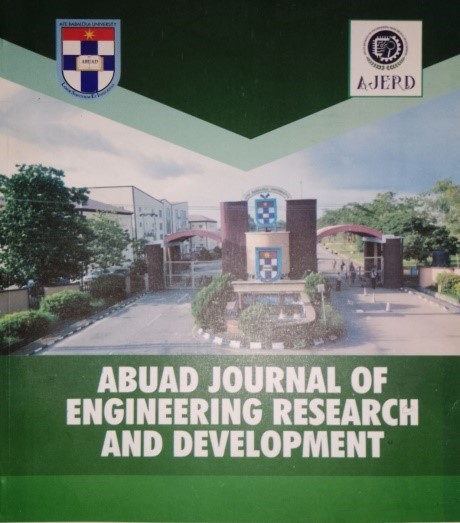Discovering the Macro-Elements Presence in Biochar Produced Indigenously
Main Article Content
Abstract
Biochar boosts soil fertility and helps plants to withstand drought. Its production locally has been a challenge and that is why an Indigenous Biochar Production Kiln (IBPK) was conceived, designed and fabricated at the Workshop of the Agricultural Technology Department, Federal Polytechnic, Ile-Oluji, Ondo State, Nigeria. IBK convert biomass to carbon-rich organic material through thermal energy. The IBPK has two drums, the Internal Retort Drum (IRD) and External drum of diameters and heights of 350 mm x 600 mm and 500 mm x 800 mm respectively. The total weight of the IBPK was 82.50 kg. The IRD of 116 kg/m3 volume was loaded with 55 kg biomass from wood waste, covered, and placed inside the external drum. The space between the outer wall of the IRD and the inner wall of the outer drum was 75 mm enough to contain firewood lighted and covered to produce the heat needed for the wood waste inside the IRD to convert it to Biochar. Smoke from the IBK escaped through the chimney attached to the external drum’s lid. The operating time for the carbonization was 182 minutes and the conversion efficiency of the IBPK was 71 %. The average temperature of the IBPK during the conversion was 269 °C. The test carried out on the produced Biochar showed the presence of macro elements that included Nitrogen (2.95%), Phosphorus (21.79%), Potassium (4.95%) and Carbon (70.31%). The fabrication cost was Fifty-Two Thousand, Two Hundred Naira only (₦52,200:00). The IBPK is recommended for farmers to produce Biochar as needed for improved farm yield, and young graduates who want to go into Biochar production as a way out of unemployment.
Downloads
Article Details
References
AOAC (2012). Official Method of Analysis: Association of Analytical Chemists. 19th Edition, Washington DC, 121-130.
Ashiedu, F. I. & Popoola, E. O. (2021). Design, Development and Testing of a Biochar Making Machine for Rural Farmers. Trends in Science & Technology Journal, 6(3), 827 – 832.
Cha, J.S., Park, S.H., Sang, C.J., Changkook, R., Jong-Ki J., Min-Chul, S. & Young-Kwon, P. (2016). Production and Utilization of Biochar: A Review. Journal of Industrial and Engineering Chemistry, 40(1), 1–15. DOI: https://doi.org/10.1016/j.jiec.2016.06.002
Intagun, W., Khamdaeng, T., Prom-ngarm, P. & Panyoyai, N. (2018). Effect of Core Puncture Diameter on Bio-Char Kiln Efficiency. World Academy of Science, Engineering and Technology International Journal of Biotechnology and Bioengineering , 12(11), 1-10.
Lehmann, J., Joseph, S. (2009). Biochar for Environmental Management : Earthscan Publishing House, London; Sterling, VA. ISBN: 978-1-84407-658-1
Moreira, M.T., Noya, I. & Feijoo, G. (2017). The Prospective Use of Biochar as Adsorption Matrix – A Review from a Lifecycle Perspective. Journal of Bioresource Technology. 246(1), 135-141 DOI: https://doi.org/10.1016/j.biortech.2017.08.041
Oyeyiola, Y. B. & Ogunlaran, A. L. (2023). Soil Acidity Ameliorative Potentials of Biochar from Sawdust and Tithonia diversifolia Feedstock. Trends Agric. Sci., 2(3): 298-309 DOI: https://doi.org/10.17311/tas.2023.298.309
Papageorgioua, A. Azzia, E. S., Enellb, A. & Sundberg, C. (2021). Biochar produced from Wood Waste for Soil Remediation in Sweden: Carbon Sequestration and other Environmental Impacts, Science of the Total Environment. 776(1), 145953. ISSN 0048-9697, DOI: https://doi.org/10.1016/j.scitotenv.2021.145953
Rumi, N., Neonyoti, B., Rahul, S.C., Bikram, B., Nirmali, G., Ajitabh, B. & Rupam, K. (2015). Biochar: An Overview on its Production, Properties and Potential Benefits. In H. Choudhury (eds.), Biology, Biotechnology, and Sustainable Development, (pp. 13-40) Research India Publications, Delhi, India.ISSN 978-93-84443-19-1
Tianhao H. (2020). Properties of Biochar from Wood and Textile. IOP Conference Series: Earth and Environmental Science. 546. doi:10.1088/1755-1315/546/4/042060 DOI: https://doi.org/10.1088/1755-1315/546/4/042060
Xu, G., Sun, J., Shao, H. & Chang, S. X. (2014). Biochar Had Effects on Phosphorus Sorption and Desorption in Three Soils with Differing Acidity. Journal of Ecological Engineering, 62(1), 54-60. https://doi.org/10.1016/j.ecoleng.2013.10.027 DOI: https://doi.org/10.1016/j.ecoleng.2013.10.027
Walter, E. (1985). Industrial charcoal making. FAO Forest Department. ISSN: 0259-2800




